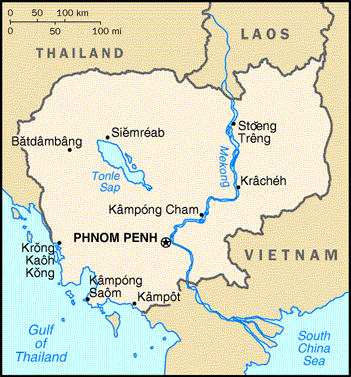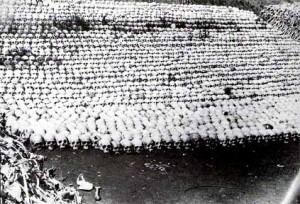-Part of the slogans used during the genocide









Cambodia is a country in South East Asia, less than half the size of California and twice the size of Scotland.
The Cambodian Genocide was carried out by the Khmer Rouge (KR) regime led by Pol Pot between 1975 and 1979. During this time 2-3 million people were murdered. The KR policies of forced relocation of the population from urban centers, mass executions, use of forced labor and malnutrition led to the deaths of an estimated 25 per cent of the total population. Before the genocide occurred, the population of Cambodia was just over 7 million, with a predominate Buddhist population.

Pol Pot leading Khmer Rouge troops
With Pol Pot's leadership, the Khmer Rouge began on an organised mission; they ruthlessly imposed an extremist program to reconstruct Cambodia. The main goal of the mission was that the population was forced to work as laborers in one huge federation of collective farms. Anyone who opposed was eliminated. Along with this; all educated people such as doctors and engineers were assumed to be a threat and must be disposed of immediately.
Using death threats; all citizens of Cambodia were forced to leave their homes. This had no exceptions and the sick, disabled, old or young were forced out regardless of the capability to leave. Absolutely no one was spared. Individuals who refused to leave were murdered on the spot. The Khmer Rouge also vigorously interrogated its own troops, and frequently executed members on suspicions of treachery or sabotage.
Pol Pot removed all civil and political rights. Children were removed from the family and placed in labor camps. Factories, schools and hospitals were shut down. Lawyers, doctors, teachers, engineers, scientists and professional people in any field (including the army) were murdered, along with their extended family.

Bodies of those who refused to leave were left on the street to rot
Religion was now banned and all Buddhist monks were killed and all temples were destroyed. The Khmer Rouge also targeted those of ethnic Chinese, Vietnamese and Thai descent. Half of the Muslim population was murdered along with 8,000 Christians. Things such as music and radio were also banned. An individual could be shot simply for knowing a foreign language, wearing glasses, laughing or even crying. Personal relationships were discouraged in the labor camp,along with expressions of affection.
Those who managed to escape being murdered became unpaid workers who worked with minimal rations and for incredibly long hours daily. Prisoners soon became weak from malnutrition and over exhaustion. If one fell sick, there was no treatment seeing as doctors were all killed and hospitals shut down; and the individual was left for death. Survival in Khmer Rouge Cambodia was determined by one’s ability to work. Starvation played a large role in the Genocide as over 2 million people are estimated to have died from starvation during this time.
The murders began with a warning from the KR in the labor camps. People receiving more than two warnings were sent for "re-education," which meant near-certain death. Prisoners were taken to mass-grave sites and were told that they would be forgiven if they admitted to "pre-revolutionary lifestyles and crimes" which essentially meant any free-market activity or contact with foreigners. Prisoners were then taken away to prisons such as Tuol Sleng and Choeung Ek for torture and/or execution. In order to save ammunition, the executions were often carried out using poison, spades or sharpened bamboo sticks. In some cases the children and infants of adult victims were killed by having their heads bashed against the trunks of Chankiri trees. Tuol Sleng translates into "Hill of the Poisonous Trees".
The buildings at Tuol Sleng have been preserved to represent how they were when Khmer Rouge were driven out in 1979. The regime kept extensive records, including thousands of photographs. Several rooms of the museum are now lined, floor to ceiling, with black and white photographs of some of the estimated 17,000 prisoners who passed through the prison..Some victims were required to dig their own graves; their weakness from starvation often meant that they were unable to dig very deep. The soldiers who carried out the executions were mostly young men or women from peasant families. Since 1995 mass graves began to be uncovered, revealing the genocide's extent. The resurrected bones and skulls have been preserved to create memorials of the dead in 'the killing fields' where they died.

Skulls and bones of victims in a discovered Killing Field. Over 20,000 killing fields have been found

Waterboard displayed at Tuol Sleng Museum. Prisoners' legs were shackled to the bar on the right,
their wrists were restrained to the brackets on the left, and water was poured over their face, using
blue watering can, to drown them.
These conditions of genocide continued for three years until 1978 when Vietnam invaded Kampuchea and overthrew the Khmer Rouge. Vietnam took control and set up a "puppet government" based off Vietnam's communist government founded mainly from KR members that had defected. Unfortunately Pol Pot's policies had ruined the economy. Cambodia lay in ruins under the newly-established Vietnamese regime as all professionals, engineers, technicians and planners who could reorganize and restart Cambodia had been murdered.

Timeline Of The Cambodian Genocide:
1975 – Year Zero, as it was called, marks the beginning of the Khmer Rouge regime.
1975 – Tortures and executions all across the country. The social categories in focus are intellectuals, teachers, doctors, former military police members, lawyers, and anybody else opposing the regime. This is the year with the most casualties.
1976 – The country is renamed Democratic Kampuchea, to mark the beginning of a new era. The name is the old form of the contemporary form Cambodia.
1977 – The Cambodian-Vietnamese War begins.
1978 – Cambodia is invaded by Vietnam.
1979, January – The Khmer Rouge rule is over.
The Khmer Rouge had this desire to bring the nation back to a “mythic past.” Outside nations were considered a corrupting influence and by stopping entrance into the nation the KR was able to restore the country to an agrarian society.This new agrarian society was to be based on Stalinist ideals (See Holodomor for more details).The manner in which they tried to implement was one factor in the genocide.
Comparing the Holocaust, Cambodian genocide, and Armenian Genocide; all were unique, but they also shared the common idea of racism. Along with racism, religious minorities were targeted, and the attempt to expand territory (Turkestan, Lebensraum, and Kampuchea Krom)were present. The Khmer Rouge was attempting to “purify” Cambodian society. By targeting various ethnic, social, political groups, as well as leaders of industry,( journalists, students, doctors, lawyers) as well as the Vietnamese and Chinese ethnic groups being purged.using force, minority groups were relocated and the use of minority languages was forbidden. This was the “ethnic cleansing” of the genocide.
Before his suicide on April 15th 1998, Pol Pot stated that he had a clear conscience and denied being responsible for genocide in an interview. Pol Pot asserted that he "came to carry out the struggle, not to kill people.” Under international pressure, Vietnam finally withdrew its occupying army from Cambodia in 1989. In 2013, current Cambodian Prime Minister; Hun Sen passed legislation which made the denial of the Cambodian genocide and other war crimes committed by the Khmer Rouge illegal. Researchers still discuss whether the events in Cambodia between 1975 and 1979 can be referred to as genocide, because the massive killings which occurred there under the Khmer Rouge rule did not specifically target a certain ethnic or religious group. However, most agree that the term should be used, given the large number of casualties.
Display of the rise and frequency of HIV since 1990
Current Life Statistics in Germany Compared to Vietnam and Germany
This is a quick video which shows the methods of the Khmer Rouge. The quote near the end "We'll never learn from crimes in the past but instead use them as blueprints for the future" shows the brutal reality of genocide. Many genocides have occurred of the history of mankind but none have been prevented. This only goes to show the power of genocide and the unawareness of other countries in the world.

No comments:
Post a Comment